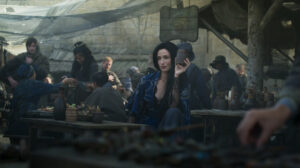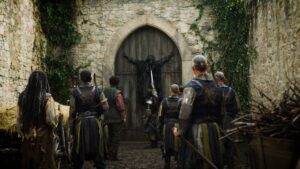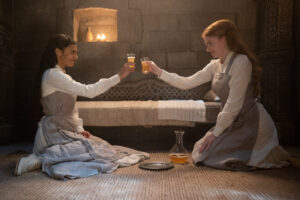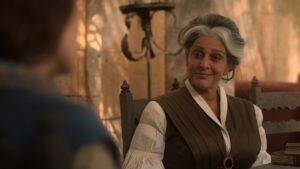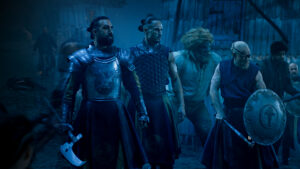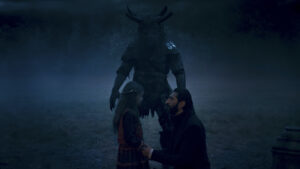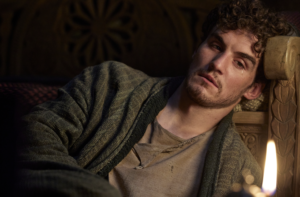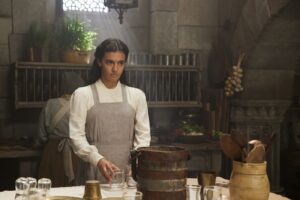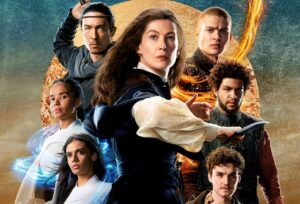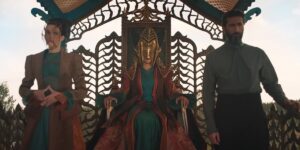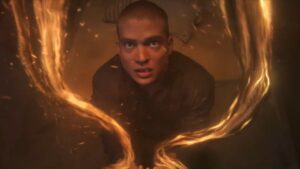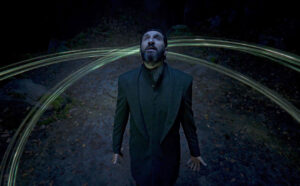MAJOR SPOILERS FOR THE WHEEL OF TIME SEASON TWO AND BOOKS 1 – 4, AHEAD!
This piece was written during the 2023 SAG-AFTRA strike. Without the labor of the actors currently on strike, the series being covered here would not exist.
I do not regard myself as a Wheel Of Time book purist. The Amazon adaptation of Robert Jordan’s massive fourteen-volume epic fantasy series has made some pretty substantial changes from page to screen, some of them unintentional but unavoidable (like when a member of the main cast abruptly left halfway through filming season one and had to be written out of the remaining two episodes), some of them purposeful (like altering the rules of the magic-system so that channelers, most of them, can’t innately sense when someone of the same sex can channel), and I have generally been accepting of this because, with all due respect to Jordan, his books are deeply flawed even by the standards of the time they were written, and I don’t think The Wheel Of Time would resonate with general audiences if it were adapted word-for-word. So with very few exceptions, I have forgiven or made peace with every change I didn’t like, while acknowledging that the majority were necessary or justifiable. Maybe I wasn’t so keen on what the show did with Agelmar in season one, but it didn’t ruin my enjoyment. I grumbled about it, and moved on fairly quickly.
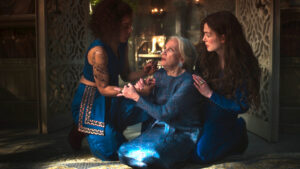
But Agelmar was also a very minor character, in the grand scheme of things. Even killing him off in the Battle of Tarwin’s Gap will have only a small impact on future events. When it comes to major characters, I confess to being more protective – though until season two, episode seven, I never really felt that I had to be, because most of the major characters I liked were obviously favorites of the writers already. Showrunner Rafe Judkins seems to share my personal preference for reading about the magic-wielding, often morally ambiguous women who make up the Aes Sedai, and that translates into more screentime for characters like Moiraine Damodred (Rosamund Pike), Liandrin Guirale (Kate Fleetwood), and Alanna Mosvani (Priyanka Bose)…too much screentime, according to those who would rather see more of the Emond’s Field Five, but never enough, if you ask me and others who find the Aes Sedai as a whole more interesting.
So for The Wheel Of Time to fumble a character I assumed was another one of Judkins’ favorites is more than a little surprising. The fact that said character just so happens to be my favorite is frustrating, and makes this personal. So let’s talk about Siuan Sanche (Sophie Okonedo).
To be clear, I don’t think anyone on the writing team dislikes Siuan. But do they regard her as a fully three-dimensional person apart from Moiraine, her lover and the lead character on the show? That’s the question I’m having a hard time answering. Siuan has only appeared in three episodes across two seasons – likely due in part to Okonedo’s busy schedule – and although she doesn’t share every one of her scenes with Moiraine, the narrative has tied her to Pike’s character, bringing Siuan out only when she’s relevant to Moiraine. So much happened at the White Tower throughout this season – the training of the two most powerful Novices in recent history, the emergence of the Black Ajah, a kidnapping – and Siuan was absent for all of it. Where was she? What was she doing? We don’t know, and the show doesn’t seem to care.
When she finally reappears, she’s immediately framed as an antagonist, placing a shield on Rand al’Thor (Josha Stradowski) – which we know, through Moiraine, to be an incredibly violating and disturbing experience for the shielded individual – and implying, without outright stating, that she means to keep Rand shielded until the Last Battle, which the Aes Sedai will win by pitting him against the Dark One, gentling him afterwards to prevent another Breaking of the World. We simply haven’t spent enough time with Siuan in the show for this apparently spur-of-the-moment decision to come off as anything but unreasonable and unethical. If the framing and dialogue didn’t already make it clear that Siuan is in the wrong here, the episode cuts away from her monologue to a scene of Egwene al’Vere (Madeleine Madden) being weaponized by the Seanchan in the exact same way Siuan describes using Rand.
Mind you, this is the exact opposite of how Siuan approaches Rand in the books. Very early in The Great Hunt, the two meet in nearly identical circumstances, albeit at a different time, in a different place. An easily intimidated Rand believes Siuan is out to get him (because men can’t find it within themselves to trust women, even in fantasy), and Siuan doesn’t exactly assuage his fears, but the reader is privy to an earlier conversation between her and Moiraine where she reveals that they were to “bring him to Tar Valon, where we could hide him, keep him safe and guide him.” No mention of shielding him, caging him, or using him as a weapon; not so much as a hint. Now, that’s not to say Siuan wasn’t wary of Rand in the books, but she’s acutely aware that he can’t be controlled, mostly because he’s the subject of prophecies, and prophecies have a way of fulfilling themselves in this particular world, without exception. Hence why she ultimately decides to let Rand go off on his own, or at least to give him the illusion of free will in the matter. Of course, the show has diverged from the books in the past many times, but this time I simply can’t justify the deviation when it makes Siuan come across so poorly, especially to fans of the show.
Because Siuan has conspired with Moiraine in the past, some have speculated that the two had a plan going into the meeting with Rand – and have pointed to Siuan’s sidestepping language as proof that she didn’t ever actually intend to keep Rand caged, but guided him to that conclusion so he’d be more willing to trust Moiraine, who comes off very rational and heroic, pointing out the glaring flaws in Siuan’s proposal and pleading with her to let him go. Call me cynical, but I don’t buy it. The plan would have to be so complex that laying it out for the audience later on would only be confusing. And unless the plan fell apart somewhere along the way (requiring even more explanation), Siuan wouldn’t have gone alone to the Waygate to stop Moiraine from leaving with Rand; she certainly wouldn’t have exploited the oath that Moiraine swore to her in season one to make her close the Waygate against her will, when there were no other Aes Sedai around and Rand didn’t even know such an oath existed. No knowing looks pass between her and Moiraine, and Moiraine doesn’t say anything to Lan (Daniel Henney) when they’re alone in the next episode that hints at a conspiracy. The evidence doesn’t add up.
Rather, we’re left with the impression that Siuan is just that confident in her absolute power that she would openly declare Rand the Dragon, bring him back to the Tower, and expect him not to be gentled upon arrival…and if we saw for ourselves the authority she commands over the Aes Sedai, maybe we could believe it, but we’ve seen the opposite. Her right-hand woman, Leane Sharif (Jennifer Cheon Garcia), was openly threatened by Liandrin in episode four. Three Novices were kidnapped by the Black Ajah under everyone’s noses, and several Aes Sedai, including a Sitter of the Blue Ajah, were captured or killed by the Seanchan. The show’s version of Siuan talks a big talk but has no tangible control, and this is again in contrast to the books, where at least for a time she is shown to be a strong and capable leader.
With this in mind, even the costuming department’s decision to dress her up in the most ostentatious version of the Amyrlin Seat’s traditional regalia with an askew headdress of golden baubles, and a heavy, floor-length fur-coat that gives off strong “Denethor from the Lord Of The Rings trilogy” vibes, feels deliberate. Siuan has always been a character who abstains from flaunting her power and wealth. “Even the nearly ten years since she had been raised to the Seat had not made her comfortable with too much luxury,” it is noted in The Dragon Reborn, where Jordan describes in great detail the spartan furnishings of her chambers in the White Tower. Now, Siuan isn’t above intimidating people if it comes down to it, but these heavy furs and layers of gilding just make her seem smaller, more vulnerable, weighed down by the trappings of her position.
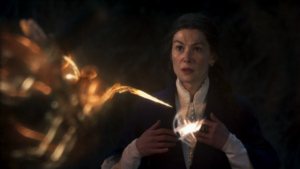
In short, my feelings on the matter boil down to this: if Okonedo could only appear briefly in season two, bringing her character in at the very end to oppose the by-now beloved protagonists of the series was an unwise and potentially damaging use of her limited screentime. Siuan is already being demonized by the fandom for “betraying” Moiraine and Rand. Granted, it doesn’t take much for a fandom to abruptly turn on Black characters, Black women especially, and anything Siuan does or says will inevitably be blown out of proportion, but the writers still made the choice to pit her – a Black woman with very little screentime and interiority – against a white woman with the lion’s share of both. And they show their favoritism towards the latter in this episode, going so far as to have Moiraine’s sister Anvaere (Lindsay Duncan) deliver an uncharacteristically tearful monologue in her behalf.
Never mind that Moiraine, throughout this season, has been acting recklessly self-sacrificial, and Siuan has every right to be frustrated with her, even angry. Obviously, being shielded wasn’t Moiraine’s fault, and sure, she wants to believe it won’t slow her down, but it does, and she knows better than anyone how imperative it is that they stay one step ahead of the Dark One. But instead of admitting that and making arrangements for Siuan to take on some of the responsibilities of protecting Rand, she hid the truth, insisting to herself that she could do everything on her own, even without the Power at her fingertips. And that’s fine, all very much in-character for Moiraine. The writers really get her.
But it’s another example of how, when Moiraine makes a mistake or does something downright heinous, the writers go out of their way to show us her reasoning and reassure us of who she is and what she stands for; we don’t ever get the same insight into Siuan’s thought process, and it’s a disservice to one of the strongest and most influential characters in the world of The Wheel Of Time. The Amyrlin Seat deserves to be more than a foil to Moiraine or a beat in her emotional journey, and that’s the real issue here. Not that Siuan made an error, or that she’s morally gray, which are fine and acceptable qualities in a character.
As I’m sure you can guess from the length of my rant, the mishandling of Siuan in this episode brought down my rating considerably, though there are – perhaps shockingly – things I liked, too. Okonedo and Pike are excellent, and their depiction of a love that endured for decades breaking down over the course of a single day is heartwrenching to witness, however you feel about the circumstances. Seeing their characters young and idealistic in flashback, just prior to the event that rocked their world, sheds a little more light on their distinct but complementary philosophies. We learn, too, from this glimpse into the past that there was a time when Moiraine and Siuan did not feel the need to conceal their romantic relationship (it was really cute to see them running through the halls of the Tower, hand-in-hand), and can surmise that the layers they’ve had to put between them to protect their mission have contributed to their growing distrust of the other’s true agenda.
Trust, or the lack thereof, is a major factor in everything that unfolds in this episode – even Moiraine’s long-awaited power-up is a result of her explicitly placing her trust in Rand to cut the knot shielding her from the True Source (in a scene that unfortunately can’t help but feel somewhat anticlimactic and cheap, after the several episodes spent following Moiraine through the long, arduous process of getting back on her feet after losing the One Power, analyzing all her trauma responses in depth). Siuan and Moiraine can trace many of their current problems back to Lan’s misinterpretation of Moiraine’s unwavering trust in his loyalty leading to her pushing him away for his own safety as her having lost all trust, which directly resulted in him sharing the true identity of the Dragon Reborn with Alanna and her Warders, and trusting Siuan to rescue Moiraine from herself. Lan’s actions, in turn, caused Moiraine to actually start distrusting both him and Siuan. Meanwhile, sweet innocent himbo Rand trusts the Forsaken Lanfear (Natasha O’Keeffe).
Lanfear’s intervention on Rand and Moiraine’s behalf is the final nail in the coffin, as far as Siuan is concerned, and you know I’m on her side here. Sure, the Wheel weaves as the Wheel wills and all that, but if the Dragon is colluding with the Forsaken and Moiraine is allowing it to happen, they have to be stopped before they inevitably walk straight into a trap. Anyway, Siuan goes to the Waygate to do just that, sees Moiraine channeling, and incorrectly assumes that Moiraine was lying to her all along about being shielded – and is therefore a Darkfriend. Hence why she resorts to using the Oath to prove that Moiraine is still on the side of the Light. As much as I personally dislike this plotline for its one-sided focus on Moiraine’s perspective, it does one thing right in that it brings back something seemingly insignificant from the first season – the Oath Moiraine swore to “honor and obey Siuan Sanche” – and gives it unexpected relevance in the story going forward, encouraging us to go back and revisit that original scene with the benefit of hindsight. The Wheel Of Time‘s foreshadowing is, as always, exceptionally clever.
And speaking of foreshadowing, I have to mention the scenes with Mat Cauthon (Dónal Finn) that are chock-full of hints and teases for future events. Whisked off to Falme by Lanfear, Mat finds himself an honored guest of the Forsaken and receives the dubious gift of insight into his past lives, courtesy of a hallucinogenic tea. He catches glimpses of himself killing and being killed many times over, and his alcoholic mother Natti (Juliet Howland) reappears for the second time this season to instill in him the fear that he’s just like her and his absent father, an inherently bad person with a soul that’s been bound to the Dark through countless Turnings of the Wheel. This isn’t entirely true, but still, you might wanna make a note of what Mat sees in his visions. Additionally, this scene gives us subtle confirmation that Mat is – as many of us have long-suspected – queer, as he flirts with Ishamael (Fares Fares), who is himself deeply queer-coded and has attempted to seduce all three ta’veren boys while completely ignoring the girls.
As for Perrin Aybara (Marcus Rutherford), he’s been a much larger presence throughout the second season but in this episode he takes a backseat, mostly watching on in utter confusion as his traveling companion, the Aiel spear-maiden Aviendha (Ayoola Smart), reunites with two warriors from her homeland and willingly submits to being beaten into a pulp by the both of them, which she casually explains to Perrin later was a fulfilment of her unpaid debt or “toh” to the Aiel warrior who died trying to save Aviendha’s life in the battle where she was taken captive. Ji’e’toh, the Aiel system of honor and obligation, never made much sense to me in the books, and it still doesn’t, but I’m weirdly happy that it’s not being simplified or downplayed for the show. Like Aes Sedai corporal punishment and everything to do with the Seanchan, it goes to show that none of the cultures and institutions that inhabit this world are without their own problematic aspects.

And that goes for characters as well, but it’s been weeks and I’m still having trouble accepting this version of Siuan Sanche that, while brilliantly portrayed by the incomparable Sophie Okonedo, is the complete inverse of Siuan as originally written. It surprises me just how strongly I feel about this. I’ve always thought myself more impartial because I had (and have) my fair share of complaints about the books, but I suppose everyone has that one character that they feel extremely protective over, and mine is apparently Siuan. If, in season three, Siuan’s role is expanded and she is no longer made out to be an antagonist or reduced to Moiraine’s love interest, it’s entirely possible I will revisit this divisive episode with newfound appreciation someday. But not today.
Episode Rating: 7/10
